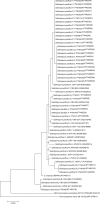The Madeira Archipelago As a Significant Source of Marine-Derived Actinomycete Diversity with Anticancer and Antimicrobial Potential
- PMID: 27774089
- PMCID: PMC5053986
- DOI: 10.3389/fmicb.2016.01594
The Madeira Archipelago As a Significant Source of Marine-Derived Actinomycete Diversity with Anticancer and Antimicrobial Potential
Abstract
Marine-derived actinomycetes have demonstrated an ability to produce novel compounds with medically relevant biological activity. Studying the diversity and biogeographical patterns of marine actinomycetes offers an opportunity to identify genera that are under environmental pressures, which may drive adaptations that yield specific biosynthetic capabilities. The present study describes research efforts to explore regions of the Atlantic Ocean, specifically around the Madeira Archipelago, where knowledge of the indigenous actinomycete diversity is scarce. A total of 400 actinomycetes were isolated, sequenced, and screened for antimicrobial and anticancer activities. The three most abundant genera identified were Streptomyces, Actinomadura, and Micromonospora. Phylogenetic analyses of the marine OTUs isolated indicated that the Madeira Archipelago is a new source of actinomycetes adapted to life in the ocean. Phylogenetic differences between offshore (>100 m from shore) and nearshore (< 100 m from shore) populations illustrates the importance of sampling offshore in order to isolate new and diverse bacterial strains. Novel phylotypes from chemically rich marine actinomycete groups like MAR4 and the genus Salinispora were isolated. Anticancer and antimicrobial assays identified Streptomyces, Micromonospora, and Salinispora as the most biologically active genera. This study illustrates the importance of bioprospecting efforts at unexplored regions of the ocean to recover bacterial strains with the potential to produce novel and interesting chemistry.
Keywords: Madeira Archipelago; anticancer activity; antimicrobial activity; cultivable bacterial diversity; marine actinomycete phylogeny; marine actinomycetes; marine sediments; natural product discovery.
Figures





Similar articles
-
Diversity and bioprospecting of culturable actinomycetes from marine sediment of the Yellow Sea, China.Arch Microbiol. 2015 Mar;197(2):299-309. doi: 10.1007/s00203-014-1059-y. Epub 2014 Nov 23. Arch Microbiol. 2015. PMID: 25416124
-
Marine Rare Actinomycetes: A Promising Source of Structurally Diverse and Unique Novel Natural Products.Mar Drugs. 2019 Apr 26;17(5):249. doi: 10.3390/md17050249. Mar Drugs. 2019. PMID: 31035452 Free PMC article. Review.
-
Actinomycetes from the South China Sea sponges: isolation, diversity, and potential for aromatic polyketides discovery.Front Microbiol. 2015 Oct 1;6:1048. doi: 10.3389/fmicb.2015.01048. eCollection 2015. Front Microbiol. 2015. PMID: 26483773 Free PMC article.
-
Rare actinomycete bacteria from the shallow water sediments of the Trondheim fjord, Norway: isolation, diversity and biological activity.Environ Microbiol. 2007 Nov;9(11):2756-64. doi: 10.1111/j.1462-2920.2007.01387.x. Environ Microbiol. 2007. PMID: 17922759
-
Actinomycetes as Producers of Biologically Active Terpenoids: Current Trends and Patents.Pharmaceuticals (Basel). 2023 Jun 12;16(6):872. doi: 10.3390/ph16060872. Pharmaceuticals (Basel). 2023. PMID: 37375819 Free PMC article. Review.
Cited by
-
Diving Into Reef Ecosystems for Land-Agriculture Solutions: Coral Microbiota Can Alleviate Salt Stress During Germination and Photosynthesis in Terrestrial Plants.Front Plant Sci. 2020 May 25;11:648. doi: 10.3389/fpls.2020.00648. eCollection 2020. Front Plant Sci. 2020. PMID: 32523601 Free PMC article.
-
Predicting Antifouling Activity and Acetylcholinesterase Inhibition of Marine-Derived Compounds Using a Computer-Aided Drug Design Approach.Mar Drugs. 2022 Feb 8;20(2):129. doi: 10.3390/md20020129. Mar Drugs. 2022. PMID: 35200658 Free PMC article.
-
Phylogenetic and Physiological Diversity of Cultivable Actinomycetes Isolated From Alpine Habitats on the Qinghai-Tibetan Plateau.Front Microbiol. 2020 Oct 2;11:555351. doi: 10.3389/fmicb.2020.555351. eCollection 2020. Front Microbiol. 2020. PMID: 33117304 Free PMC article.
-
Generation of a high quality library of bioactive filamentous actinomycetes from extreme biomes using a culture-based bioprospecting strategy.Front Microbiol. 2023 Jan 19;13:1054384. doi: 10.3389/fmicb.2022.1054384. eCollection 2022. Front Microbiol. 2023. PMID: 36741889 Free PMC article.
-
In Silico HCT116 Human Colon Cancer Cell-Based Models En Route to the Discovery of Lead-Like Anticancer Drugs.Biomolecules. 2018 Jul 17;8(3):56. doi: 10.3390/biom8030056. Biomolecules. 2018. PMID: 30018273 Free PMC article.
References
LinkOut - more resources
Full Text Sources
Other Literature Sources
Molecular Biology Databases
Research Materials

